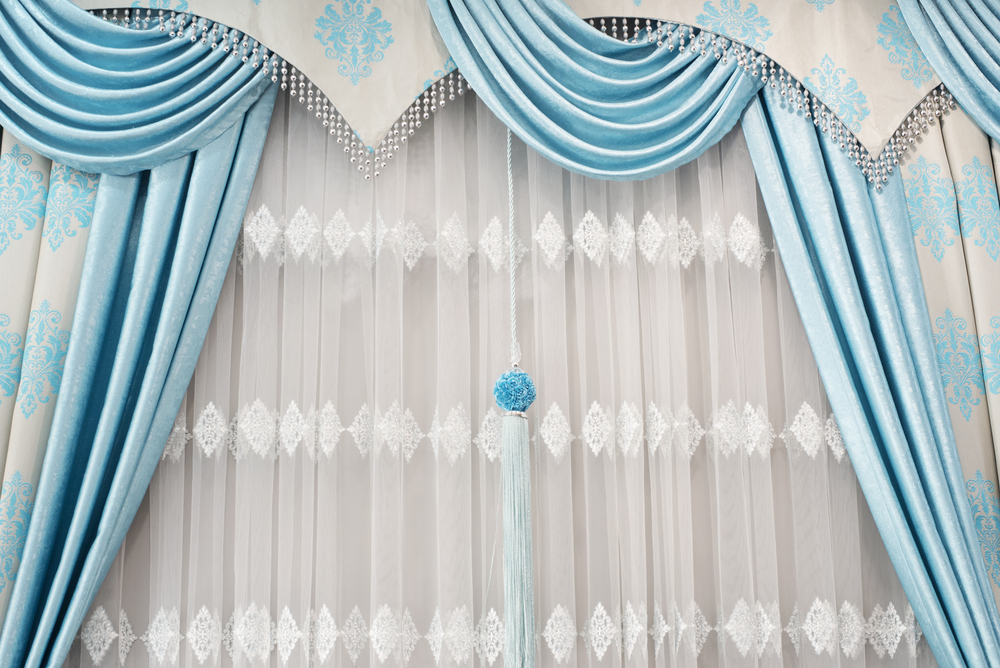Whether you’re decorating a room in your home or a small space for an upcoming event, there’s likely come a time when you wondered what the difference is between drape vs. curtains. While they may look the same at first glance, they vary in style and function. The nuanced differences are what makes them so unique. When looking for a way to dress up your living room, kitchen, or event space – you’ll want to consider these differences before deciding which option is best for you.
We’re here to break down the differences for you, so you can decide which is the best to include in your home or for your next event.
Let’s take a closer look at drape vs. curtains.
Jump Links
- Drape vs. Curtains: A Definition
- The Differences in Materials
- The Different Functions
- Design
- Installation & Hardware
- Key Takeaways: Drape vs. Curtains
- FAQs about Curtains and drape
Drape vs. Curtains: A Definition
When looking for new window treatments – drape and
curtains are likely the two top choices you’ve considered. Both options are stylish yet functional and available in different looks and sizes. They both also provide a put-together look to any space you pick to dress up with drape or curtains.
While they’re similar in look and functionality, they add a different look and feel to your home and have different definitions.
Drape are made with a heavy-weight fabric. This allows them to be great options for blocking out the sun, reducing noise, and keeping your home insulated. With drape, you never need to worry about unwanted sun seeping through the cracks because the heavy-weight fabric provides next-level security. Drape are also decorative and great for events.
Pipe and drape are a simple yet effective way to make any event space more intimate and inviting. It’s a tool that event planners use to add dividers, create photo booths, and create temporary walls in the room. The drape are thick enough to use for most events.
Curtains are also available in different fabric lengths, sizes, and thicknesses. Whether you want a sheer cover or looking for a blackout material – you’re sure to find an option that can accommodate your needs. Curtains are made with fabric panels and designed to perfectly fit your windows or sliding glass doors. Curtains are typically lower cost and more versatile. They come in different materials and can be designed to fit the needs of the space of your home.
Curtains are better options for homes and small spaces. The panel-style window coverings are perfect for adding a layer of privacy to any space in an elegant and elevated way.
| Drape | Curtains | |
| Definition | Heavyweight window coverings made of thick fabric | Lightweight window coverings made of sheer or thin fabric |
| Function | Block light and provide privacy | Filter light and offer minimal privacy |
| Length | Floor-length, often pooling on the floor | Various lengths, ranging from window-length to floor-length |
| Fabric | Heavyweight fabrics like velvet, brocade, or suede | Lightweight fabrics like linen, cotton, or polyester |
| Lining | Often lined with blackout fabric for light blocking | May or may not be lined |
| Appearance | Formal and luxurious | Informal and versatile |
| Style | Usually pleated or gathered with deep folds | Often hung in simple panels with minimal pleating |
| Use | Commonly used in formal settings or rooms requiring light control | Suitable for casual and formal settings, depending on fabric and style |
| Maintenance | Require professional cleaning due to weight and fabric type | Can be machine-washed or dry-cleaned, depending on fabric |
| Cost | Generally more expensive due to heavier fabric and lining | Typically more affordable than drape |
The Differences in Materials
One of the main differences between drape and curtains is the material used. Both options are available in a variety of materials and colors. Different materials provide a different look to a space, so you’ll want to consider the look and feel you’re going for to find the best option.
Types of Materials for Drape
Satin
Satin is a soft, shiny fabric with a high-end look and feel. This is a great material for draper because of the lustrous material. This luxurious material is great for weddings, events, and birthdays. It looks elevated and expensive but is relatively durable, making it great for pipe, drape, or special occasions.
Velvet
Velvet is a high-end, luxurious material great for drape. The thickness is perfect for blocking out the sun, and the material provides a high-end look and feel to your space. Velvet is a great material for special occasions. It’s high-end, durable, and thicker than other options – making it great for lavish events and special occasions.
Patterned
Patterned drape are a great tool that you can take advantage of to add a pop of color to your space. These are typically textured and made with high-quality material. Patterned drape are great for living rooms, bedrooms, and special events.
Types of Materials for Curtains
Sheer
Sheer curtains provide a dreamy effect to a space. They are soft to the touch and textured, making them great for adding light to your space and enhancing the ambiance. Sheer still provides privacy, making them perfect for kitchens, bedrooms, and living rooms.
Cotton and Linen
Cotton and linen curtains have a beachy look and feel. They’re great for adding an elevated or beachy touch to the space in your home. Even though cotton and linen are lightweight, it’s great insulators that protect yous from cold air and harmful UVB rays.
Patterned
Curtains are also available in a variety of colors and patterns. Since curtains invite more light into your space, they provide a dynamic look and feel.
The Different Functions
drape and curtains have different functions. While both are useful, they provide your space with different privacy and decorative touches. When deciding which is best, you’ll want to consider your needs and what you’re looking for.
The function of Drape
Light Control
drape is typically made with a thicker material, making them great for blocking out sun and light. They are the better option if you completely block out the light from outside to control the light in a particular space.
Insulation
drape provide next-level insulation and noise reduction. Whether it’s sunny, cold, or windy, you can feel confident that drape will help protect your space.
Privacy
drape are great for adding a layer of privacy to your space. They are designed with a thicker material that is functional and stylish. Since drape are made with thicker material, they do provide next-level privacy.
Function of Curtains
Light Filtering
Curtains are designed to filter the light that comes into a space. Most curtains are made with a sheer material that filters the light rather than completely blocking it. This makes them great for homes and spaces with great natural lights or to add a sheer touch to a room.
Decoration
Curtains add a decorative component to your space. They come in different lightweight materials that are functional, practical, and stylish. You can choose from materials, colors, and styles to complement your space.
Privacy
Curtains provide an extra layer of daytime privacy and protection. While most don’t completely block the sun from your space, they will add an elevated touch of privacy that allows you to still enjoy the sunshine.
Design
drape and curtains are both designed to elevate your room. They add a visual effect to your space and complement different details and elements. These stylish yet functional design components come in different designs and colors. Whether you’re looking for a beachy chic aesthetic or to keep things sleek with a modern design, there’s sure to be a drape, curtain design, or style out there for you.
Design and Style of Drape
Drape are made with a thicker material and can elevate your space or decorate it for an event. Whether it’s a wedding, party, or a special occasion – the design of drape can be used to tie together all of the intricate details of your event.
Here are a few of the most popular types:
- Pleated drape
- Mix and match the satin
- Shimmer Sheer
- Swag
- Lace paired with sheer
That’s only to name a few. drape are available in a variety of fabrics. Whether you’re looking for shimmery drape for your wedding or drape with a pleated design – you’re sure to find something that compliments the look you’re going for.
Design and Style of Curtains
Since curtains are made with thinner fabric, you’ll often see bold colors, vibrant designs, and fun styles you can play with. Each style is designed to bring a different creative component to your space and tie all the details together. The designs and styles change with the different trends. Here are some of the most popular curtain styles you can consider for your space:
- Layering different sheer materials
- Playful shapes and abstract lines
- Cotton, bamboo, or organic-looking materials
Installation & Hardware
When installing drape or curtains, you’ll want to consider your use case and the layout. For example, if you’re renting drape for your wedding, you’ll probably want to let the professionals set up your drape. This will ensure the vision for the drape will come together, and you can worry about other details of your wedding. However, if you’re installing curtains in your home, you most likely will be able to follow the directions and set it up on your own.
How to Install Drape
Drape can be trickier to install, especially for events. Drape tend to be longer and made with a thicker material, which means they require different tools to make sure they hang correctly. When installing drape in your home, you’ll want to install them above the window. You may need to measure the drape and the space between the window and the floor. Drape are made to barely kiss or touch the floor, so you’ll want to ensure you’re not installing them too high or too low.
How to Install Curtains
Curtains are installed similarly. You’ll want to hang them above the window the same way you would with the drape. However, not all curtains are made to touch the floor. So you’ll need to measure the space before hanging the bar or installing any hardware.
Hardware for Drape and Curtains
The most essential hardware needed to install drape or curtains in your home is a curtain rod, screws, and brackets. You’ll need this hardware to hang your curtains right above the window. You can also hang your curtains or drape with rings, grommets, or a fabric sleeve.
Key Takeaways: Drape vs. Curtains
When choosing between drape vs. curtains, it depends on how you plan to use them and what you use them for. If you’re looking to decorate an event space or a venue, you may decide that drape are the better choice. If you’re looking for something to help filter or block the light in your living room, curtains may be the better choice.
If you’re looking for drape or pipe and drape for your next event, we’re here to help. Contact us today at Quest Events to learn more.
FAQs about Curtains and Drape
What are the disadvantages of drape?
One of the disadvantages of drape is they take up more space. You may want to go with blinds or shorter curtains if you have a small space. drape can get in the way and make a small space look cluttered. This option is suited for a space with vaulted ceilings and large windows. This also means that drape can make a space look and feel smaller than it is. Which is great for small intimate get-togethers but not for a room in your home.
What is the difference between curtains and drape?
There are a few key differences between curtains and drape. Certains are typically defined as a piece of cloth hanging from the top of your windows. They are designed to keep light out of your space or to filter the light to add a soft, subtle touch to your living room, event space, hotel rooms, and more. drape are similar to curtains, but it’s a longer piece of cloth. They are designed to hang and drape down your window as curtains do, but they have a more dramatic look and create that “wow factor” that makes them great for events and special occasions.
Are curtains or drape better?
This depends on what you are using the drape for and how you want to use them. If you’re planning an event and want to divide a room into smaller spaces, drape are the better option. If you want to add window shades to your living room, curtains may be a better option. Always consider where you want to use them and how you want to use them to ensure you find the best possible solution for your project.


